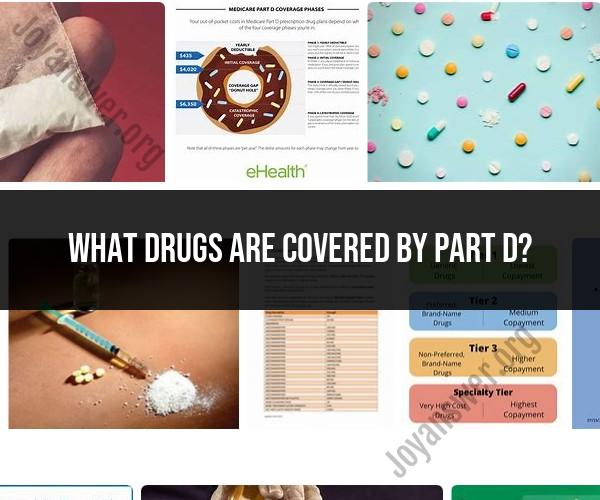What drugs are covered by Part D?
Medicare Part D prescription drug coverage covers a wide range of medications, but the specific drugs covered can vary from one Part D plan to another. However, there are certain guidelines and requirements that all Part D plans must follow regarding covered drugs. Here are some key points to understand about the types of drugs covered by Medicare Part D:
Formulary: Each Part D plan has a list of covered drugs called a "formulary." The formulary includes both brand-name and generic drugs that the plan covers. These drugs are chosen by the plan's pharmacy and therapeutics (P&T) committee.
Coverage Requirements: Part D plans are required to cover at least two drugs in each therapeutic category and class. This ensures that there are multiple options available for treating various medical conditions.
Common Covered Medications: Part D plans typically cover a range of medications, including but not limited to:
- Prescription drugs used to treat chronic conditions like diabetes, hypertension, and high cholesterol.
- Medications for acute conditions, such as antibiotics and pain relievers.
- Vaccines recommended by the Centers for Disease Control and Prevention (CDC).
- Many commonly prescribed brand-name and generic drugs.
Excluded Medications: Part D plans are not required to cover all drugs. Some categories of drugs that are generally not covered include:
- Over-the-counter (OTC) medications that do not require a prescription.
- Drugs used for cosmetic purposes.
- Certain weight loss or weight gain drugs.
- Drugs used for fertility.
- Drugs for erectile dysfunction (with a few exceptions).
- Medications for symptomatic relief of cough and colds.
Specialty Medications: Some Part D plans may include a separate tier or coverage category for specialty medications, which are often used to treat complex or rare medical conditions. These drugs may have higher cost-sharing requirements.
Prior Authorization and Step Therapy: Part D plans may require prior authorization or step therapy for certain medications. Prior authorization means your doctor must get approval from the plan before prescribing certain drugs. Step therapy means you may need to try lower-cost drugs first before the plan covers a higher-cost medication.
Annual Formulary Changes: Part D plans can make changes to their formularies, such as adding or removing drugs, during the plan year. However, they must provide notice to beneficiaries affected by these changes.
To find out which specific medications are covered by a particular Part D plan, you can:
- Use the Medicare Plan Finder tool on the official Medicare website (medicare.gov).
- Contact the plan directly.
- Review the plan's formulary document, which is available on the plan's website or can be requested from the plan.
It's important to carefully review the formulary and other plan details during the Annual Enrollment Period (AEP) each year to ensure that the plan you choose covers the medications you need at a cost that fits your budget.
Prescription Drugs Covered by Medicare Part D: What You Need to Know
Medicare Part D is a voluntary prescription drug coverage program that is available to Medicare beneficiaries. Part D plans are offered by private insurance companies, and they cover a wide range of prescription drugs. However, there are some drugs that are not covered by Part D, such as over-the-counter drugs, weight loss drugs, and cosmetic drugs.
Navigating Medication Coverage: Understanding Part D Drug Lists
Each Part D plan has its own drug list, or formulary. The formulary is a list of all the prescription drugs that are covered by the plan. The formulary is divided into tiers, and each tier has a different cost-sharing structure. Tier 1 drugs are the cheapest, and tier 5 drugs are the most expensive.
Medication Access Through Part D: Covered Drugs and Formularies
To find out if a particular drug is covered by your Part D plan, you can check the plan's formulary. You can usually find the formulary on the plan's website or by calling the plan's customer service department.
If a drug is not covered by your Part D plan, you may be able to request an exception. To request an exception, you will need to contact your plan and provide a medical justification for why you need the drug.
Tips for Navigating Medicare Part D Drug Lists
Here are some tips for navigating Medicare Part D drug lists:
- Check the formulary before you enroll in a plan. Make sure that all of your prescription drugs are covered by the plan's formulary.
- Compare the formularies of different plans. Some plans have more comprehensive formularies than others.
- Request an exception if a drug is not covered. You may be able to get an exception if you have a medical need for the drug.
- Talk to your doctor about your prescription drug needs. Your doctor can help you to choose the right Part D plan for your needs and to make sure that you are getting the best possible price on your medications.
If you have any questions about Medicare Part D drug lists, you can contact Medicare at 1-800-633-4227 or visit the Medicare website.










